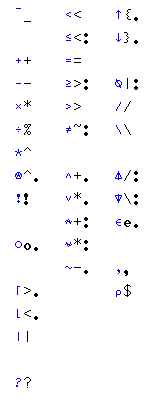Ken Iverson developed another computer language, J, in the years before his passing.
J is very strongly reminiscent of APL. At first glance, it even appears to simply be APL with an unusual, but efficient, transliteration scheme. Thus, in J, / and \ have the same meanings as they do in APL, and so the percent sign % is used as the division operator.
When I first encountered that, I considered it to be a very bold move, but I have since found that the Digital Equipment Corporation had previously used the % sign as a division operator in the ASCII transliteration used with APLSF. J differs from that transliteration in many ways; for example, ^ stands for the exponentiation operator, star in APL, while in APLSF, it is used to represent up-arrow.
However, J is much more than a transliterated APL. It provides a number of constructs that are not only beyond anything provided in previous extensions to APL, but indeed of a sort that it is very unlikely anyone else might have envisaged.
While it is inaccurate to characterize J as a transliterated APL, I do not see it as unreasonable to supply a chart of APL operators together with their J counterparts as a starting point.

While many J operators are unmistakably derived from APL operators, and, thus, there is a J operator equivalent to the circle operator in APL, and I have omitted in the chart at left equivalencies between some J operators and those in later versions of APL, there are also significant differences between APL and J that have led me to make the chart at the right a relatively short one.